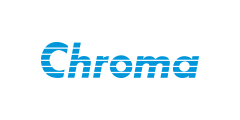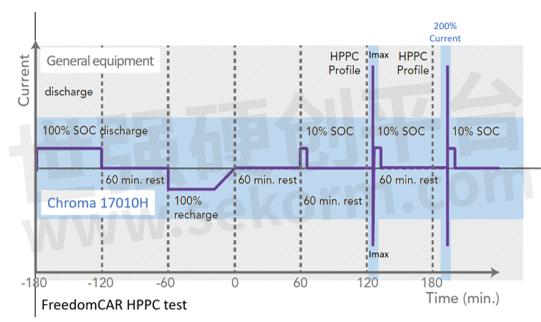Chroma 17010H Battery Reliability Test Solution for Lithium Batteries with Ultra-low DC Internal Resistance, Achieving 200% Pulse Current Output

Internal resistance is a key parameter that determines the power capability, energy efficiency, and heat generation of lithium-ion batteries. It is also an important indicator of the state of health (SoH) of the batteries, which affects the acceleration, fast charging, and cooling system design of electric vehicles (EVs). In addition, in order to avoid battery abuse and improve battery safety and service life, the Battery Management System (BMS) needs to establish an internal resistance model to accurately manage the power capability. Therefore, research on internal resistance and power capability plays an important role in developing next-generation battery cells and optimizing battery systems. However, as it has become a trend for manufacturers to adopt ultra-low DC internal resistance and enlarge single-cell designs as a means to improve the power density of electric vehicles, general equipment is increasingly unable to deliver the required test current of thousands of amperes, which usually leaves test engineers with a limited choice of expensive equipment.
Nowadays, battery internal resistance measurement technology is mainly divided into two types: 1) DC resistance is primarily determined by using pulse (step) current to measure the potential difference, which is then used to calculate the internal resistance value; 2) AC resistance is determined with electrochemical impedance spectroscopy (EIS) using disturbance spectrum technology. Due to the complex electrochemical properties of the battery, the DC resistance cannot be directly compared with the AC impedance. The two measurement techniques are complementary due to the difference in the analyses' time domains and are mostly selected according to the application conditions.
In terms of EV and energy storage system design, pulse current is often used to test DC internal resistance. In addition to the short test time, research has shown that current amplitude also affects the internal resistance of the battery and that the high-current pulse test more closely approximates real load applications. The internationally standard methods for pulse current test are the VDA current step method and the Hybrid Pulse Power Characterization (HPPC) test, with pulse widths between 100mS-30S.
The voltage drops are impacted by various phenomena related to internal resistance, depending on their respective measurement timescales: ohmic resistance of the transient voltage drop, equivalent capacitance, and interface electric charge transfer resistance during the first few seconds of the voltage drop, and polarization resistance of slower response due to ion diffusion (Figure 1). The total resistance is calculated from the results of the pulse test. It should be noted that a greater pulse width may change the state of charge (SOC) and cause additional voltage drops leading to deviations in the internal resistance measurement. Conversely, a pulse amplitude that is too small will lead to a significant increase in measurement uncertainty. Measurement errors may also be caused by current/voltage measurement errors and temperature control errors.

(Figure 1) The relationship between DA pulse test voltage change and battery internal resistance equivalent circuit
During USABC HPPC tests, the internal resistance and power characteristics of the battery are calculated by subjecting battery cells to 10~30S of maximum pulse discharge and 10S of maximum pulse charge under different SOCs with the aim of measuring the change in electric potential. By this principle, if a 60Ah lithium battery cell needed to have its pulse working current (10C-rate) tested 10 times, it used to be necessary to purchase 600A charging and discharging equipment. But not anymore, because now CHROMA provides a 200% pulse current test solution!
The single channel current capacity of Chroma 17010H is 300A, which can be amplified with Super Mode to output 200% current (600A) within 30 seconds, especially suitable for pulse current performance testing. The new design focuses on battery applications and optimizes the power output mode, leading to a 50% reduced footprint and a 30% reduction in price (Figure 1).
Key to the high pulse current capability designed by Chroma is the power circuit's temperature control. First, the 17010H's high-conversion-efficiency energy recovery architecture greatly reduces the heating of components during charging and discharging. Second, it increases the operating current by optimizing power module integration and component selection. Finally, heat flow design is applied to achieve temperature control. As for measurement, a distributed high-precision current transformer structure that ensures current accuracy is supplemented with a cold and hot area circuit layout to reduce temperature drift, together forming an integrated battery test system that achieves 200% pulse current output.

(Figure 2) The benefit of 200% pulse current Mode
The key advantages of the Battery Reliability Test System Chroma 17010H:
High measurement reproducibility helps testers to save considerable time on trend judgment and characteristic analysis.
Zero-crossover and fast current response capabilities provide test results that closely correspond with real applications.
Multiple current range design improves the accuracy of small currents, with a minimum current range of 1:10 and suitable ranges for both high and low-rate performance tests.
Discharge energy recycling efficiency of 75% not only saves on operating power and decreases the waste heat from air conditioning, but also reduces laboratory power distribution requirements.
Independent Level 2 V. Protection function strengthens the safety of high current testing.
- +1 Like
- Add to Favorites
Recommend
- Chroma Launches Next-Generation High-Performance Power IC Test Platform Chroma 3650-S2 Equipped with up to 768 pins, 200Mbps data rate
- Chroma Regenerative Test Solutions Accelerate Net-Zero Transition
- Chroma ATE Showcases Advanced Test Technology to Propel the AI Revolution at SEMICON Taiwan 2023
- Sekorm Became an Official Authorized Distributor of Chroma
- Chroma ATE Inc. Featured in Forbes Asia‘s Best Under A Billion 2023, Showcasing Consistent Top- and Bottom-Line Growth
- 8610 Battery Pack Integrated Testbed for Testing New Energy Vehicle Battery Systems and Subparts | Chroma
- Chroma Test Setup for Complete Gamma Measurement on Video Signal Generators
- Chroma 62000d Programmable Bidirectional Dc Power Supplies Have Both Power Source and Load Characteristics
This document is provided by Sekorm Platform for VIP exclusive service. The copyright is owned by Sekorm. Without authorization, any medias, websites or individual are not allowed to reprint. When authorizing the reprint, the link of www.sekorm.com must be indicated.





























































































































































































































































































































































































































































































































































































































































































































































































































































































